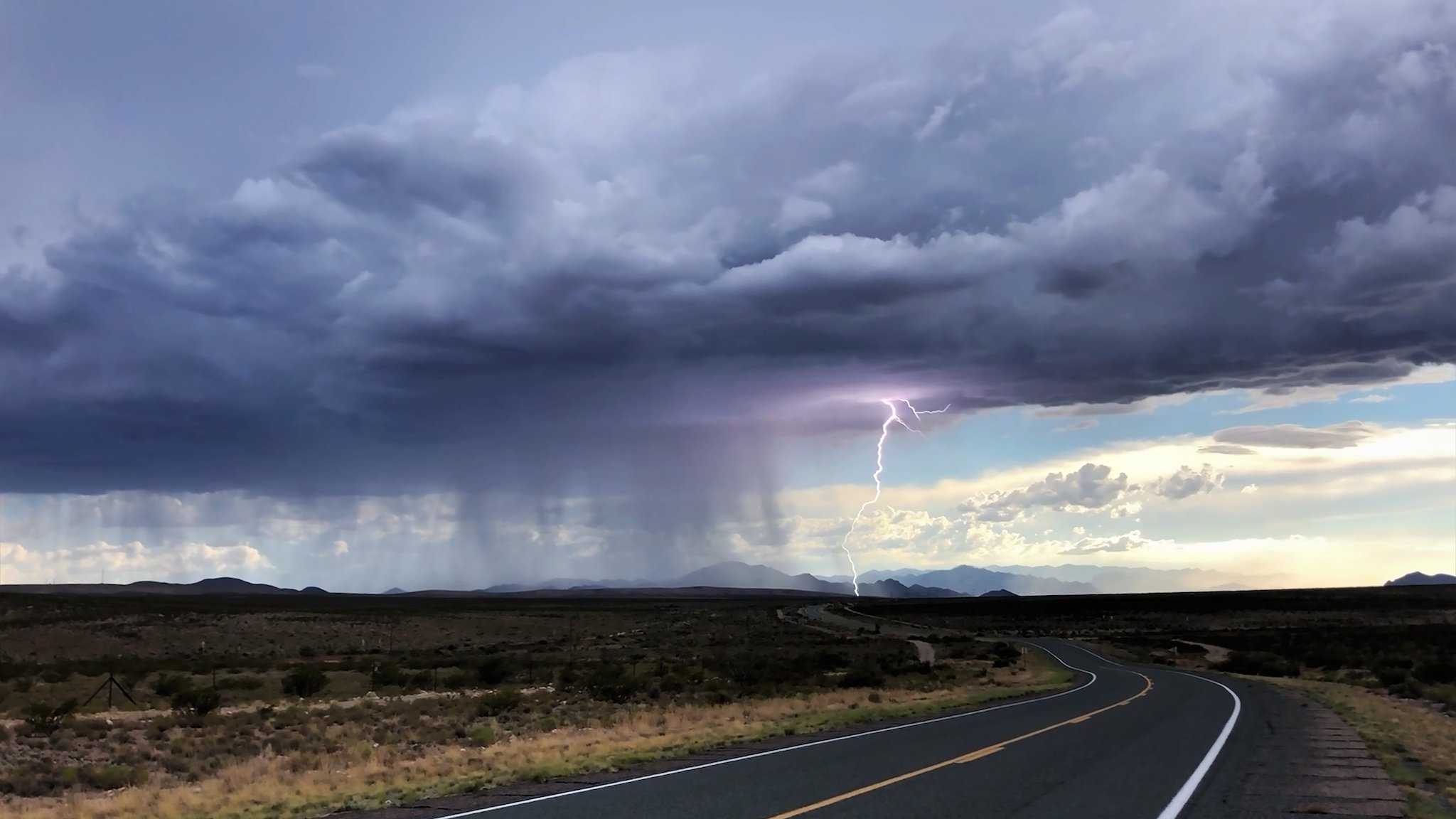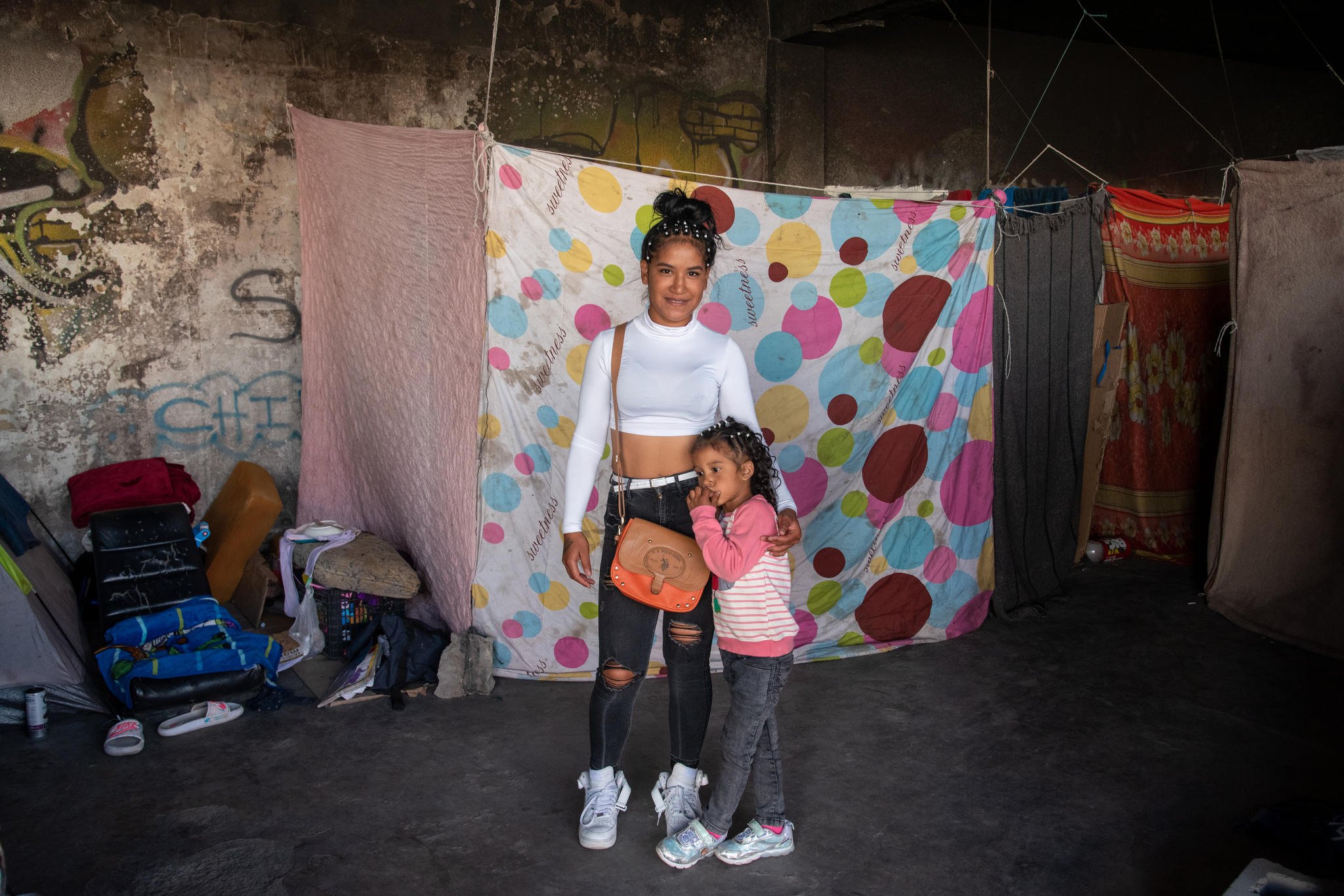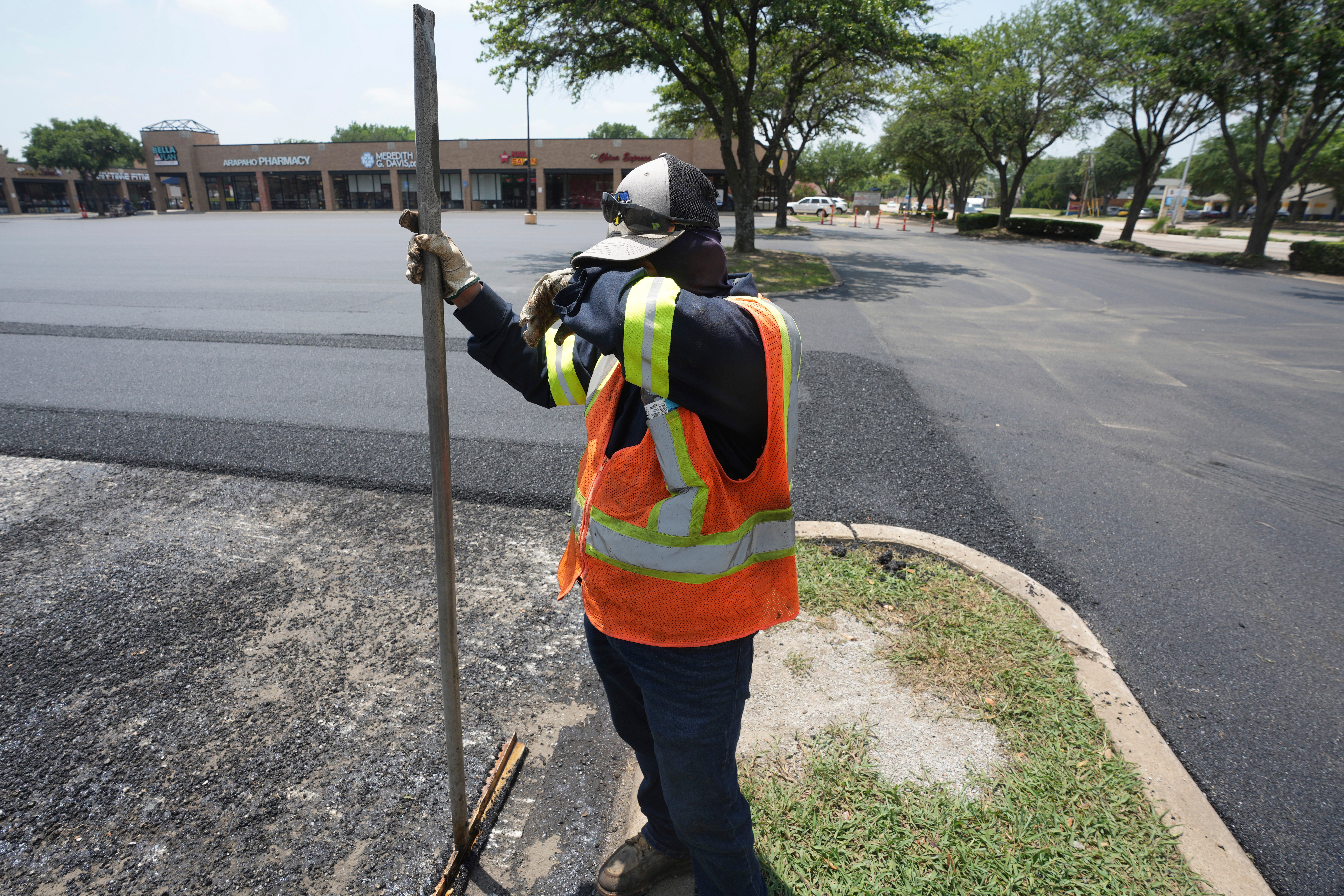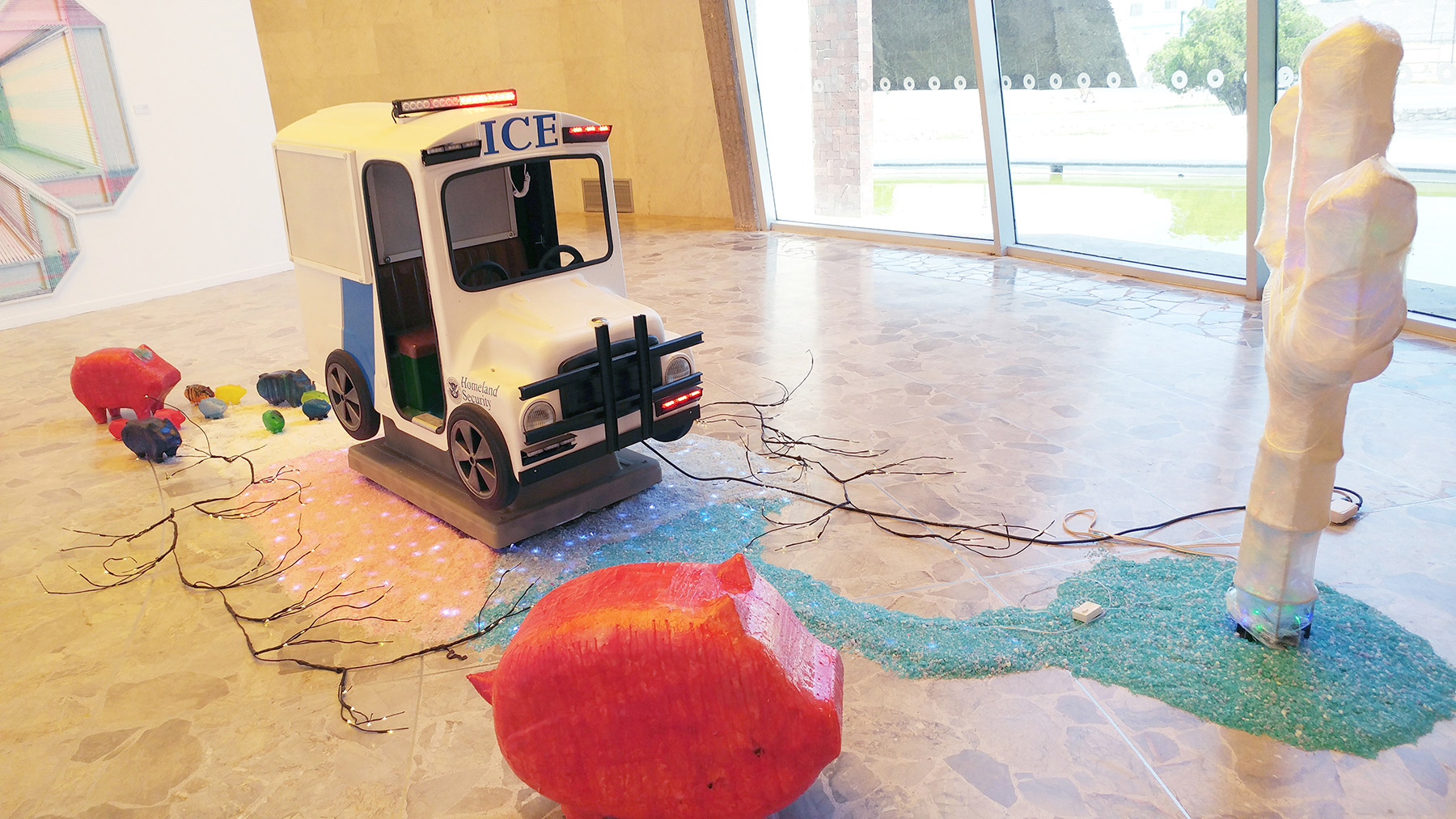
100 Ways to Draw a Line
The edge becomes the center at the Transborder Biennial 2018 in El Paso and Ciudad Juárez.
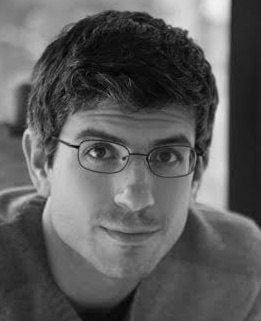
A version of this story ran in the August 2018 issue.
100 Ways to Draw a Line
The edge becomes the center at the Transborder Biennial 2018 in El Paso and Ciudad Juárez.
Nearly 80,000 people cross the border in the El Paso-Ciudad Juárez metro region every day, for reasons ranging from work, education and family to migration, asylum and trafficking. This summer, at least a few of those crossings will be for the purpose of viewing art. At a moment of political crisis, when security has never been tighter, more militarized or less humane, two museums on either side of the Rio Grande are asking visitors to take to the bridges and join those for whom the border — corridor for some, obstacle for others — is a defining fact of life.
“Transborder Biennial 2018,” on view through September 16, is the fifth iteration of a 10-year-old collaboration between the El Paso Museum of Art (EPMA) and Museo de Arte de Ciudad Juárez (MACJ). Half the show is at the first museum, a mile north of the river; the other half is at the latter, 3 miles into Mexico. All told, the binational exhibition features nearly 100 pieces by more than 30 artists, all of whom live within 200 miles of the border. Every artist in the show has at least one piece on display at each museum. As a result, moving from museum to museum, and country to country, has the effect of doubling one’s exposure to the same set of aesthetic ideas. This is in keeping with a conception of fronterizo art that runs through the show. “When you’re so close to another culture, it’s not two cultures becoming one,” says Victoria Ramirez, director of EPMA. “It’s one culture. That’s it.”
Many of the artists cross regularly or have family on both sides of the border. Even those whose lives are more rooted in one country seem destined to explore the same themes as their neighbors on the other side. To take one example, Gabriel Boils Terán of Tijuana works with maps, altering official Mexican government surveys of border regions to erase everything north of the boundary. Terán replaces all detail on the U.S. side with gray background and text in fonts reminiscent of graffiti and gothic tattoos, such as “Et in Arcadia Ego,” “Terra Incognita” or “Hic Sunt Dracones” — Latin phrases conjuring old maps whose clean lines trail off into unexplored territories where monsters or paradise might lie.
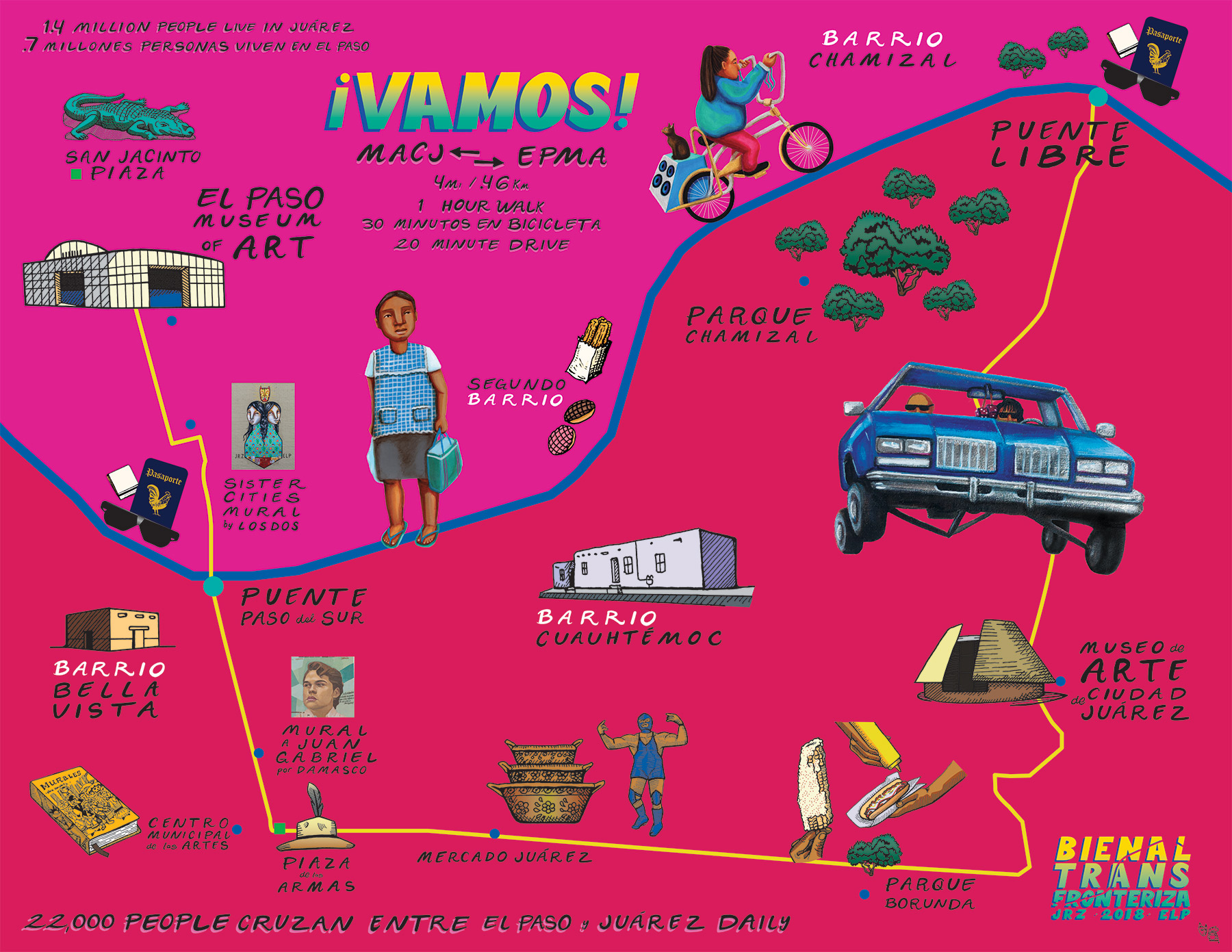
Terán’s jokey, streetwise wall hangings are echoed, hazily and expressively, by the lovely paintings of Tony de los Reyes of Los Angeles. De los Reyes’ “calexico supermoon” series is made up of panels divided vertically by thin, colored stripes; on either side of this division is a broad, smooth color field interrupted by a quasi-circular splotch of paint. The result could be interpreted as a Rothko-esque experiment with pure hue. In context, it’s clear that de los Reyes is also contrasting the cosmic beauty of the desert “super moon” with the unnatural division underneath it.
Among the most moving pieces in the EPMA show is “Foosball: By Kicking and Punching,” a sculpture by Laredo artist Gil Rocha-Rochelli, who has constructed a life-size table football game as a metaphor for the deadly drama of immigration control (pictured above). Just under half of Rocha-Rochelli’s foosball players are black-clad representatives of the U.S. security state, signified by police shields mounted on baton-shaped rods. On the opposing side are several rows of worn-out shoes, representing migrants; their rods are old broom handles. The shoes evoke both the nature of overland migration and those who go missing in the border deserts. The goalie for the migrant side is a small child’s shoe; her broom handle has fallen out of position, revealing a sharp nail.
“It could be seen as a key for the whole show,” says Kate Green, curator for EPMA, of Rocha-Rochelli’s sculpture. “You have a sense of play and also danger. The game is leaning; it’s broken; it’s not a level playing field. It’s engaging a vernacular language, but also twisting it a bit.”
The underdog energy of the show, which overlaps with the art-history notion of rasquache — or irreverent, cobbled-together art — is also powerful among the many artists in the show who hail from El Paso and Ciudad Juárez. For these artists, the biennial is as close as the national and international art worlds come to visiting and possibly reckoning with their hometown scene. With about a third of its artists hailing from the area, the Transborder Biennial doubles as a survey of what’s happening in Texas’ most remote metropolis. The picture that emerges is that of a vibrant city flowering with young, sophisticated artists. Their work, on themes like migration and borders, is grounded in personal experience but at the same time relevant to the biggest political questions of the 21st century.
No-Family’s Land
The pamphlet designed to accompany this year’s Transborder Biennial does not include any miniature images of the artwork on display, but instead takes the form of two maps, colorfully designed by El Paso muralist team Los Dos. One map traces the entire U.S.-Mexico border, with dots indicating the home bases of the artists on display. Another lays out the route between the two museums, past landmarks of the two cities’ intertwined history. The journey, to a great extent, is the destination.
The unmistakable centerpiece of that journey is the crossing of the Rio Grande. On foot, three types of visual impressions dominate. One is a kind of portraiture: the other people on the pedestrian bridges, mostly daily border-crossers, and the clothing, luggage and other cultural markers of that varied demographic. A second is still life: the security buildup, especially on the American side, with different areas for people of different visa statuses. Third, a landscape: the no-man’s land under the bridge.
Below the bridges, there is no one wall to mark the border in downtown El Paso-Juárez, but several, separating customs zones, train tracks, a brimming canal for diverted Rio Grande waters claimed by the United States, and the contained trickle of the actual river.
That once great and rugged riverbed is the secret setting for the photographs at the heart of Ingrid Leyva’s “Hugsport” project. Leyva, 30, was born in Ciudad Chihuahua, grew up on both sides of the border and lives in El Paso. “Hugsport” was inspired by an event known as Hugs Not Walls, put on by the El Paso-based Border Network for Human Rights. Families that wish to reunite but are unable to freely cross the border meet on plywood platforms in the muddy center of the Rio Grande, embracing for a few minutes before being nudged back to one side of the river or the other. The event has been held five times since 2016; Border Patrol agents tolerate it and do not interfere.
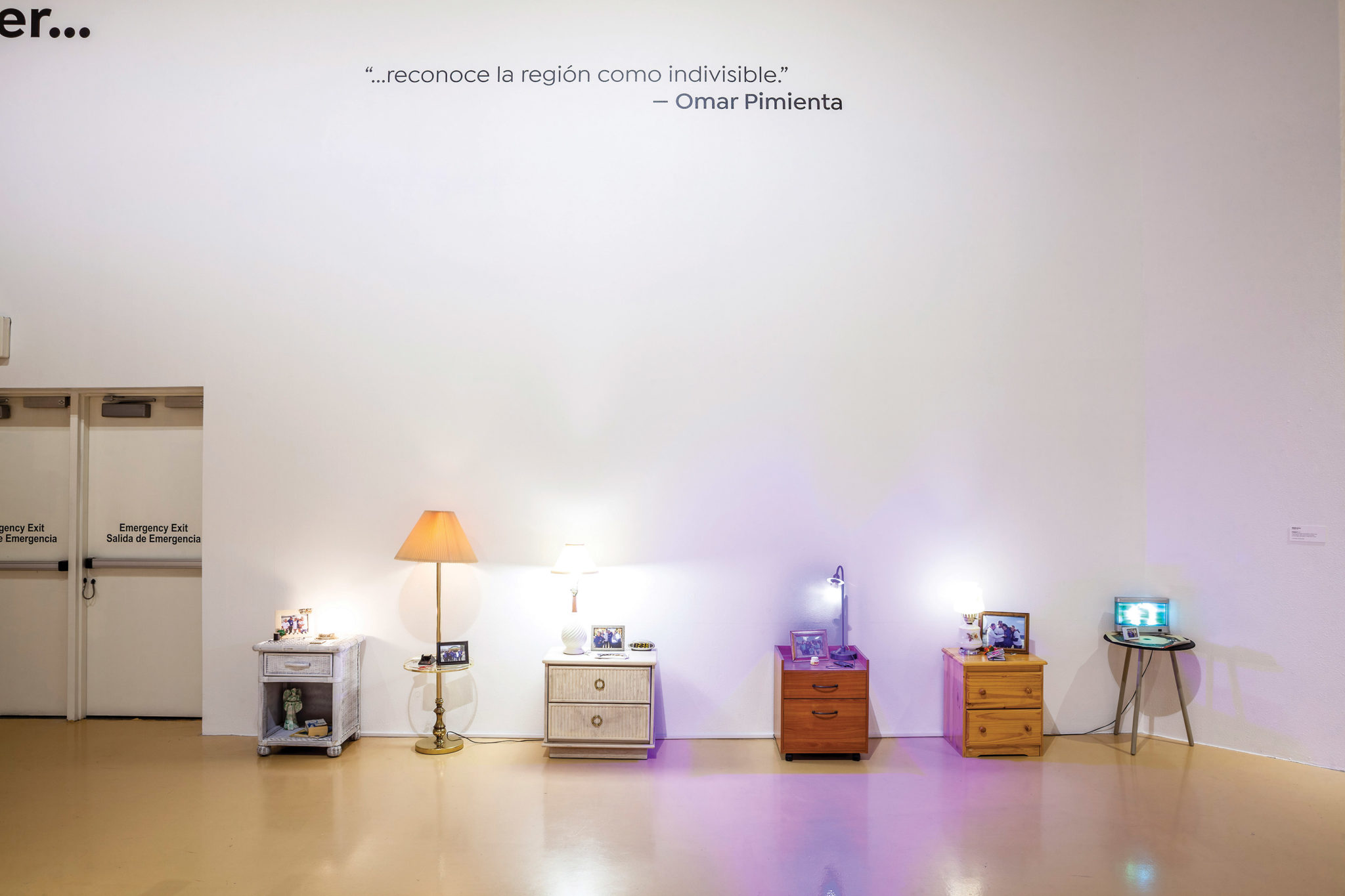
Leyva printed out family pictures from the event, cut away the backgrounds and pasted them onto more idyllic backdrops for a family vacation, such as the beach, or a tourist site in El Paso. She mounted these photos in cheerful frames and arranged them on nightstands alongside phones, lamps and other objects, such as mixed pocket change in pesos and U.S. coins.
“This project began when I started wondering why one of the basic human rights — that is, to be with the people we love — nowadays belongs to fiction,” Leyva writes in an email. “Why is the government criminalizing us just for not having papers — or worse, because even criminals in jails have the opportunity to be with their families? This was a long and painful process in which I decided to fix things … even if it is just through the imagination.”
“Hugsport” is sophisticated but unassuming, and it takes some searching to understand what the modest row of nightstands is meant to represent. A clue comes when, on one of the nightstands, we notice a stack of photos with the shapes of families cut out. What’s left is a view of the concrete border zone, with spectators standing on a bridge and border security vehicles in the background. Only then is the viewer pierced by the longing at the heart of the work.
Games of Resistance
Angel Cabrales is a court jester of Texas border art. His sculptures are big, bombastic and loaded with sarcastic meaning. The social criticism is cutting, and the jokes are painful, often implicating the viewer. At MACJ, Cabrales’ “DREAM a Little DREAM (ICE Homeland Security Kiddie Ride),” takes over the space both visually and musically. The mini-ICE truck is meant to evoke the sorts of rides you’d find in front of a grocery store, the ones that run for a quarter and don’t do much but shudder back and forth. That is, of course, also a familiar pattern of movement for some young immigrants trying to hang on to their lives in the United States — a whiplash of crossing, deportation and recrossing. The shape of the truck itself also seems to reference an ice-cream truck, which invites association with the hieleras, or “ice boxes,” where some border-crossers are imprisoned at abusively cold temperatures.
“DREAM a Little DREAM” is the kind of brash, easily legible yet still-affecting gesture that Cabrales has become known for in El Paso. “If I’m afraid of something, or something really bothers me, I like to laugh about it first, so that I can take it in a little easier,” Cabrales says. “If it’s something interactive, [visitors] can play with it. But I want them to think about what they just did. A part of me wants you to really enjoy what you’re looking at or interacting with, and then feel a little bad about enjoying it.”

Cabrales’ EPMA piece “A-Hole in One” dares to go even further into this logic. There’s an armchair, a pneumatic golf-ball shooter on a red turf platform shaped like the United States and, a small distance away, a putting green in the shape of Mexico. Visitors can take turns sitting in the chair and trying to launch a golf ball into a hole on the green roughly where Mexico City ought to be. The game has proved very popular with the 10-and-under set.
The reference here would seem to be to Trump, but Cabrales reminds viewers that Obama played golf, too, as do so many patriotic Americans. In an earlier iteration of this work, there were two chairs, one shooting from blue America, the other from red America, at various putting greens in the shape of North Korea, Iran and other countries recently identified as enemies of the largest military in the world. For the Transborder Biennial, however, Cabrales has stripped that original vision down in a way that speaks to racism and xenophobia as much as to militarism in foreign policy. When visitors take turns playing “armchair warrior,” in Cabrales’ phrasing, one might imagine them firing off rounds of invective as easily as bombs or bullets. The consequences of that hatred, as explored in “DREAM a Little DREAM,” are visible only once the viewer visits the other side.
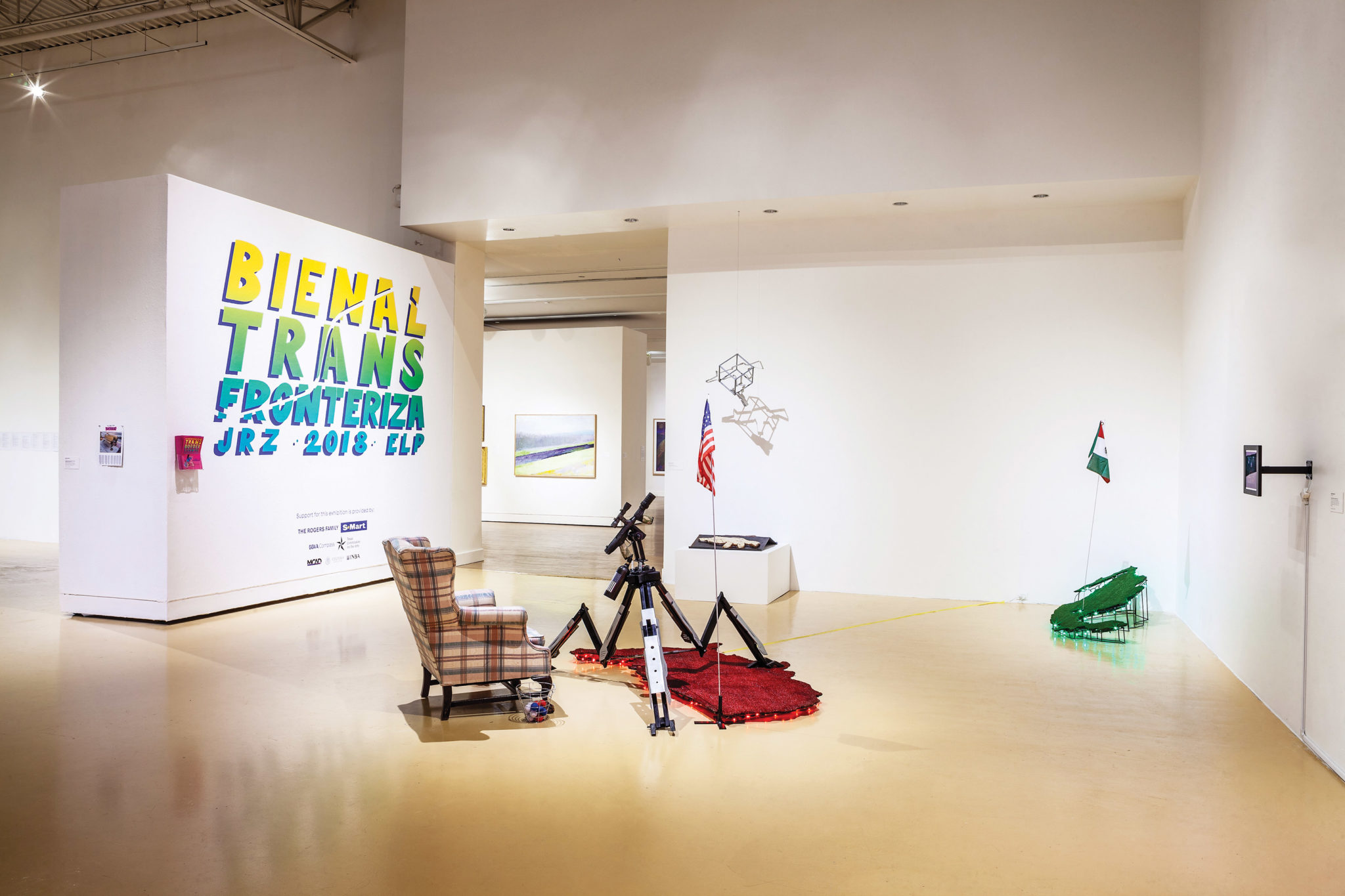
El Paso Ghosts and Monsters
Though their themes are similar, Leyva and Cabrales could scarcely be more divergent in terms of technique. The same goes for several of the other El Paso artists on view at the biennial. Adrian Esparza is one of the few artists in the show to reference folk art. He has, in “Tunnel Vision,” unwound a traditional serape blanket and composed the threads into an abstract geometrical form that may or may not have a subtle border meaning. Meanwhile, as a post-industrial counterpoint, Guillermo Gutierrez offers huge, weighty, metallic sculptures of found objects, some of the most physically impressive works on view.
A number of artists on display have based their art on archival research. El Paso’s Andrea Blancas Beltran’s “b/order (r)evolution” surfaces historical photos related to the quarantine and delousing system for border-crossers instituted during the Mexican Revolution. Implemented in 1917 by an El Paso mayor who was a eugenics enthusiast and persisting for four decades in the name of public sanitation, authorities forced border-crossers to undress, undergo inspection in genital and other areas and, if lice was found, submit to chemical baths and hair removal. Local historian David Dorado Romo has demonstrated that these “delousings” eventually involved the use of Zyklon B, an eerie premonition of the poison’s use in the Holocaust. Beltran has altered the archival photos in EPMA with text about the quarantine; viewers must cross the border to MACJ to learn more.
Moving from documentary to comics, Zeke Peña contributes several clever drawings that reimagine border scenarios in fantastic ways. In “Border Beast Detention,” shackled men glumly ride an alligator through a river. The piece is inspired, Peña says, by a 2014 Politico article titled “The Green Monster” detailing abuses by the Border Patrol, and also by the famous alligators of San Jacinto Plaza in El Paso. Another of Peña’s drawings, “Jorge Crosses the Rio Grande,” remixes the famous image of Washington crossing the Delaware with darker figures in the water beneath him, wading in the opposite direction.
These are part of a larger series for Peña, which he calls “Disaster of Walls” in homage to the great Francisco de Goya’s “Disasters of War” print series about the Napoleonic Wars in Spain. “What has always interested me about those images is the way they were disseminated, as an ongoing project,” Peña says. “The images were made, then printed, then dispersed, kind of like postcards.” Peña has collected his drawings, all of which touch on the current border crisis, into a zine and distributed it for free at locales like the Art Institute of Chicago.
Peña was part of the 2009 version of the Transborder Biennial. He says he’s noticed a major change in audience receptivity for art about the border. “I don’t know that the issues have changed, but what’s changed is that this is at the forefront of the discourse,” he says. “That’s really encouraged people from the area, and people who are not from the area, to focus on this and think about it and explore it.”
El Otro Lado
Peña is not alone in emphasizing that the work in this year’s biennial that touches on migration, border authorities and disrupted families should not be misunderstood as being solely a reaction to the election of Donald Trump. “Even previous to Trump, those were always topics that were present in conversation,” says Jair Tapia, communications director for MACJ.
That truth is especially evident in the art coming out of Juárez, where a pervasive unease cannot possibly be attributed to the 45th president. Juárez has seen a much-needed decline in violence in recent years; the respite, however, has more to do with the shifting tectonics of cartels than anything going on north of the border. A few of the Juárez artists in the show are quite young, like Alexia G. Apodaca, 23, whose short film “Regresar a Casa I” addresses the lack of adequate street lighting in Juárez and the death toll of those who risk the walk home at night. Tapia notes that Apodaca represents a generation that grew up amid the worst of the cartel violence. The trauma shows, as does, in Apodaca’s case, a new reformist energy as she and her peers come of age.
Nayeli Hernandez, 22, is another young Juárez artist; her fumage (smoke-painted) impressions of forbidding buildings shimmer with darkness. Equally mysterious and ominous are the works of Animales de Poder, an art collective working in mixed media. Their Transborder Biennial project, about secret graves in the Chihuahuan Desert, features a book that is anxiety-provoking just to flip through, composed of photos of SUVs with blacked-out license plates and X’d out diagrams of eyes. A brief moment of levity is provided by Léon de la Rosa-Carrillo, who has composed animated GIFs of magazine covers featuring Trump and Mexican President Enrique Peña Nieto, turned glitchy by inserting a few lines of poetry into the computer code. Visitors can read through the many pages of code to search out the secret poetry.

An encounter with the art of Ciudad Juárez may be a salutary experience for U.S. audiences who want to learn more about the long and sordid border history that precedes our current moment of crisis. But our visits are even more meaningful for the Juarenses. Tourism dollars have been scarce in recent years, and the MACJ — a landmark 1960s building by Pedro Ramírez Vázquez, a star architect who also designed Mexico City’s National Museum of Anthropology — could use the business.
Beyond a good deed or a learning experience, border crossing can now feel like a crucial act of citizenship. We who consider ourselves Americans are, after all, defined by not just the sealed community within territorial control of the Department of Homeland Security, but also by the many binational communities that make our country great. “Today more than ever, this kind of cultural exchange is important,” says Rosa Elva Vázquez Ruiz, MACJ director. “After all the pressure we’ve had from American government, all the politics against immigrants and this idea of closing the borders, we are opening the borders — with art.”
